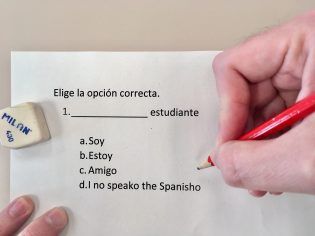
Did you know that speaking Spanish may make you question the nature of your existence? OK, you might think “that already happens to me in [INSERT LEAST FAVOURITE LECTURE HERE]”, but learning Spanish can make you do this in a positive way and actually make you see the world in a different light.
So, as part of our Language Bites series, we recorded a short discussion between two of the teachers at the Languages Service, Greg (that’s me) and Dani.


Let’s look at some of the examples that you can hear in the recording and some other useful things.
For these kinds of things you should use ser:
Facts, nationalities, jobs, physical characteristics, personality – SER
Esto es muy útil – This is very useful
Soy inglés – I’m English
¿Es mi profesora de español? – Is she my Spanish teacher?
Somos muy fuertes – We’re very strong
Son muy inteligentes – They’re very intelligent
Ser o no ser: esa es la cuestión – To be or not to be, that is the question
Location of physical things – ESTAR
Generally, when you’re talking about where something is, estar is the verb you need.
Laura no está – Laura’s not here
El supermercado está enfrente de este edificio – The supermarket is opposite this building
¿Dónde está mi profesor de español? – Where is my Spanish teacher?
Present continuous – ESTAR
Estoy escuchando – I’m listening
¿Qué estás viendo? – What are you watching?
To form the present continuous in Spanish, you always use estar, never ser.
Feelings & things that are true now, but might not be in the future – ESTAR
Está enferma – She’s ill
Estoy de acuerdo contigo – I agree with you
¿Estás enfadado? – Are you angry?
Careful: some adjectives change meaning when combined with ser or estar
¡Qué guapo eres! – You’re so handsome!
¡Qué guapo estás! – You look really smart!
Es lista – She’s clever
Está lista – She’s ready
This should give you a good idea to start with, although sometimes the difference can be quite subtle. After twenty years of trying, I’m still trying to work out what Enrique Bunbury means when he says that he “está entre dos tierras”. Let’s see if you can help me out – send your answers on a postcard (or comment below…)



